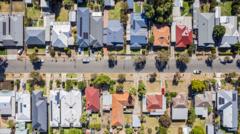The situation has become dire for many Australians, with soaring property prices and stagnant wages creating a squeeze on homebuyers and renters alike. Compounding issues such as restrictive planning laws and a decline in public housing contribute to a challenging environment for those seeking affordable housing options.
As the federal election campaign heats up, potential voters are increasingly focused on housing affordability, amid promises and plans put forth by Australia’s major political parties.
Housing affordability for Australians has plummeted at an alarming rate. With the upcoming federal election just around the corner, both the Labor Party and the Liberal-National Coalition have prioritized this crisis as a vital campaign issue.
The perfect storm of skyrocketing property prices, escalating rental rates, and a dire shortage of social housing has left many Australians struggling to buy or rent a home. For the average Sydney home, prices now soar to almost A$1.2 million, a stark contrast to wages that have failed to keep pace with such rapid inflation.
Sydney is now recognized as one of the world’s least affordable cities for housing and stands as a clear example of the mounting pressures on the Australian housing market. A growing population coupled with insufficient new housing construction has only further exacerbated the problem.
Public housing initiatives have failed to meet demand, leading to increased homelessness and overcrowding. Many factors, including climate change, have made geographical areas less livable, putting additional strain on the housing market.
While some attribute the housing crisis to immigration and foreign investments, experts argue that these factors are not substantial contributors. Temporary migrants, who primarily reside in dedicated accommodations, do not significantly affect the overall housing sector.
In response, both major parties propose to invest heavily in the building of new homes, promising Labor to deliver 1.2 million new homes by 2029, while the Coalition aims to secure 500,000. However, experts warn that such commitments might not be enough to fully address the crisis.
Both parties have offered various strategies, such as shared-equity financing to ease first-time homebuyers into the market and incentive programs for lower-income families. Yet, concerns are raised regarding the Coalition’s focus on slashing immigration, which some economists suggest will lead to long-term economic drawbacks.
Additionally, proposals for grants to first-time buyers could unintentionally drive prices up further, compounding the struggles of affordability.
Industry insiders believe that while both political platforms are making progress in recognizing the issue, a holistic approach that merges the strengths of both parties could ultimately be more effective. Time will tell how these promises will transform the Australian housing landscape and whether it will mitigate the chronic crisis that many Australians currently face.
With these critical discussions underway, the electorate is watching closely as they prepare for what could be a pivotal vote in shaping Australia’s future housing policies.
As the federal election campaign heats up, potential voters are increasingly focused on housing affordability, amid promises and plans put forth by Australia’s major political parties.
Housing affordability for Australians has plummeted at an alarming rate. With the upcoming federal election just around the corner, both the Labor Party and the Liberal-National Coalition have prioritized this crisis as a vital campaign issue.
The perfect storm of skyrocketing property prices, escalating rental rates, and a dire shortage of social housing has left many Australians struggling to buy or rent a home. For the average Sydney home, prices now soar to almost A$1.2 million, a stark contrast to wages that have failed to keep pace with such rapid inflation.
Sydney is now recognized as one of the world’s least affordable cities for housing and stands as a clear example of the mounting pressures on the Australian housing market. A growing population coupled with insufficient new housing construction has only further exacerbated the problem.
Public housing initiatives have failed to meet demand, leading to increased homelessness and overcrowding. Many factors, including climate change, have made geographical areas less livable, putting additional strain on the housing market.
While some attribute the housing crisis to immigration and foreign investments, experts argue that these factors are not substantial contributors. Temporary migrants, who primarily reside in dedicated accommodations, do not significantly affect the overall housing sector.
In response, both major parties propose to invest heavily in the building of new homes, promising Labor to deliver 1.2 million new homes by 2029, while the Coalition aims to secure 500,000. However, experts warn that such commitments might not be enough to fully address the crisis.
Both parties have offered various strategies, such as shared-equity financing to ease first-time homebuyers into the market and incentive programs for lower-income families. Yet, concerns are raised regarding the Coalition’s focus on slashing immigration, which some economists suggest will lead to long-term economic drawbacks.
Additionally, proposals for grants to first-time buyers could unintentionally drive prices up further, compounding the struggles of affordability.
Industry insiders believe that while both political platforms are making progress in recognizing the issue, a holistic approach that merges the strengths of both parties could ultimately be more effective. Time will tell how these promises will transform the Australian housing landscape and whether it will mitigate the chronic crisis that many Australians currently face.
With these critical discussions underway, the electorate is watching closely as they prepare for what could be a pivotal vote in shaping Australia’s future housing policies.




















